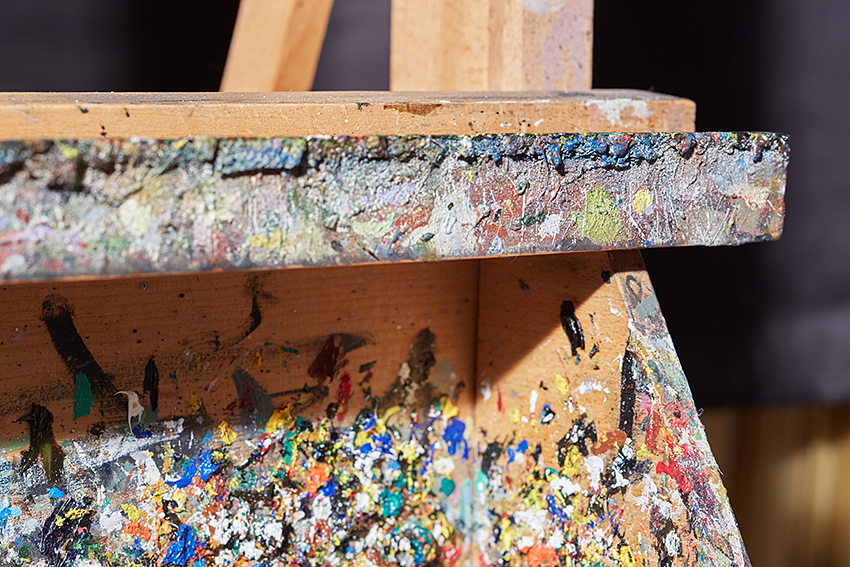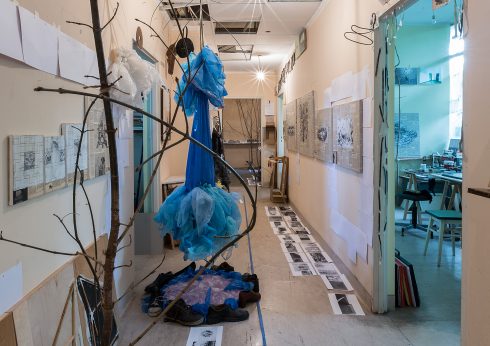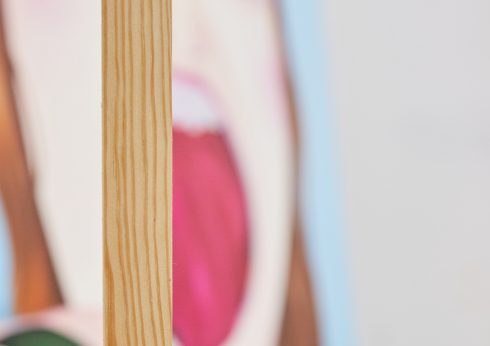
Studio of Mateusz Szczypiński
Anna Stankiewicz Małopolski Instytut Kultury w Krakowie Mateusz Szczypiński interviewed by Agnieszka Jankowska-Marzec A.J.M.: You work (...)Mateusz Szczypiński interviewed by Agnieszka Jankowska-Marzec
A.J.M.: You work in one of the rooms in your flat. How does the lack of separation between the realms of work and everyday life influence the “hygiene” of your life?
M.Sz.: It’s a very comfortable situation for me: I have my studio always “at hand” and I can start or finish painting at any time, rather than eke out specific time for work (including time for commuting to the studio). My system for creative activity has worked well for over a decade and I am very satisfied with it. I’ve tried in the past with studios outside of home. I organised the first in a garage that my grandfather used earlier, and the second, really big, in my family home. Theoretically, it offered ideal conditions, because when my parents were building a house I managed to persuade them to turn the whole attic into a studio. I could design and arrange everything the way I wanted. However, in my case, these places did not work due to the need to allot a specific time for work.
A.J.M.: Your studio is situated in a charming modernist townhouse from between the two world wars. Do you like to live and work here?
M.Sz.: Yes. Its advantages including being close to everywhere, and the location in Kraków’s Salwator district means the city centre is just a short walk away, and on the other hand, as I like active breaks from work I can escape for a bike ride or jog: it is possible as a kilometre away we have already left the city centre.
A.J.M.: It goes without saying that you like to be active here as an artist. But could you call your studio an ideal place to work?
M.Sz.: It could always be better. If I were to have an ideal studio I would imagine it as a white cube, much bigger than the space I work in. I like to be able to hang a certain number of older works on the walls and juxtapose them against what I’m currently working on. I need some time to extend the moment of finishing work on a painting too: that final “cutting off the umbilical cord”. So, the paintings hang, and I give myself some more time to perhaps return to them and change or improve something in them.
A.J.M.: What is your day in a studio like then?
M.Sz.: I start my work with “a clear head”, that is when I know that nothing is going to distract me: this is especially important when I start or finish the making of a painting. I try not to rush anything, which means that when I am tired, I like to give myself a break, do something else and clear my head. Sometimes you need to move away from a painting after 20 minutes’ work, and at other times the painting needs to be worked on for several hours without interruption. I am convinced that often it’s better to leave it for a time than to damage it by rushing it or doing “forced” work.
While working, I’m addicted to audiobooks and various podcasts, less often to music, but I generally don’t like to paint in silence. Although every now and then I sit in front of a painting and look at it, thinking about what to do next, and this happens to be something I do in absolute silence. I start working in the studio in the morning (not from the break of dawn, though), and I don’t like to work by night when I’m sleepy. I find it most difficult to start and finish a painting. The stage in between is somewhat easier, yet the start and the finish require my greatest focus and removing myself from the outside world. What I find equally important are the constant conditions of work, which means that I always paint in uniform artificial light and my window is covered with fabric. I am usually accompanied in the studio by my cat, and she makes sure that every now and then I take a break and use the opportunity to feed her.
A.J.M.: You’ve mentioned that you like hanging your paintings on the walls of the studio, but I have also noted works of other artists that belong to your collection. Don’t they break your concentration while you work?
M.Sz.: On the contrary, they allow me to realise that the painterly problems that I face are solved by others in their different ways. There are different aesthetics and artistic styles, therefore they give me a breather and let me look at what I’m currently working on from a somewhat different perspective. They help me keep a healthy distance to my artistic pursuits. Sometimes, especially when I have been working on something for a long time, I need to change my perspective in looking at what I’m doing. And you can do it in various ways; setting a painting in a new environment, by turning it “upside down” or precisely by looking at other paintings. This can be inspiring and makes it possible to discover the painting anew.




